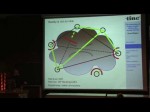by Guus Sliepen Rather than configuring tunnels, a tinc VPN is more or less specified by its endpoints. The tinc daemons will automatically set up tunnels in order to create a full mesh network. The problem in today’s Internet is that many users are trapped behind NAT, and ISPs are known to drop ICMP packets, IP fragments, and/or UDP packets, making reliable connections between peers difficult. Another problem is how to manage authentication and authorization in a fully decentralized, but user-friendly way. In this talk I will look at solutions already implemented in tinc and other VPN software, and I look at future work to solve the remaining problems. tinc is a Virtual Private Network (VPN) daemon that automatically tries to create a full mesh network between peers. It can route IPv4 and IPv6 packets, or switch any type of Ethernet packet to create a virtual LAN. It can tunnel over IPv4 and IPv6, and runs on Linux, *BSD, Solaris, MacOS/X and Windows. Links: ◦tinc-vpn.orgFOSDEM (Free and Open Source Development European Meeting) is a European event centered around Free and Open Source software development. It is aimed at developers and all interested in the Free and Open Source news in the world. Its goals are to enable developers to meet and to promote the awareness and use of free and open source software. More info at fosdem.org

Link:
tinc: the difficulties of a peer-to-peer VPN on the hostile Internet


